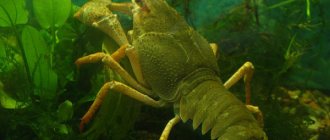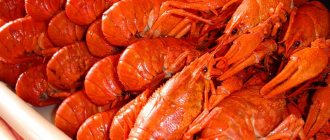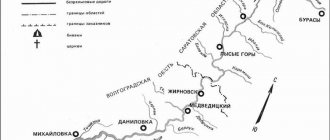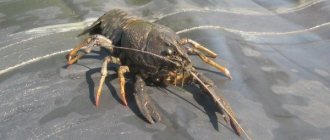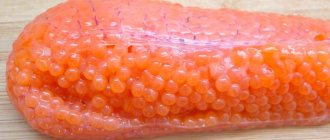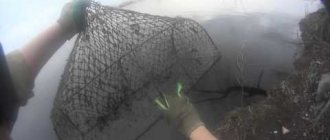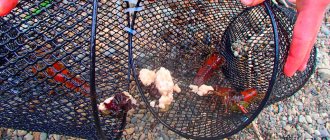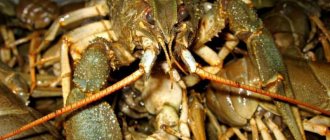Cancers: description and behavioral characteristics
Representatives of crustaceans cannot be confused. They have fairly tenacious claws that help them fight off enemies and get food for themselves. With their bulging black eyes located on their narrow heads, crayfish very carefully observe their surroundings.
Despite the small size of their mouths, crayfish have very voluminous jaws, which allow them to easily deal with prey. The chitinous shell covers the entire body of crustaceans. Thanks to the claws located on the sides of the body, representatives of crustaceans move freely along the surface of the bottom.
Crayfish are extremely clean, so they choose the cleanest possible environment for themselves. There is no point in looking for them in polluted water. In river waters, crustaceans are found much more often than in lakes, where the water is more susceptible to stagnation and turbidity. It is possible to encounter arthropods at different depths. In one reservoir they are located not far from the shore line, in another - at a depth of more than 2 meters.
During daylight hours, representatives of crustaceans guard their homes, and sensing danger, they quickly delve into the burrow. Quite often, predatory fish species attack crustaceans. But crayfish, in moments of danger, develop rapid speed and very often they manage to quickly get to the hole in order to be safe.
With the onset of darkness comes a period of activity. At this time, the cancer leaves the home and goes in search of food. Seeing something edible, it slowly moves its claws along the surface of the bottom and suddenly grabs the prey. In cloudy and rainy weather, crayfish go out hunting without waiting for evening.
Having captured the prey, the cancer will never quickly swallow it. He tries to bite off the smallest piece and savors it slowly. This is why the cancer feeding period takes a very long time.
Crustaceans are generally considered omnivores. They can feed on plant food, mollusks, small bottom animals, worms, and insect larvae. Quite rarely, but there are still cases when they attack their brothers. However, crayfish show such aggression only during periods of molting.
Where is the best place to catch crayfish?
For fishing, experts recommend choosing places with sharp cliffs, where the coastal depth is at least one meter. Places with muddy bottoms are excellent for building crustacean burrows.
However, rocky places are considered to be the most favorite habitat. It is here that the crayfish feel completely safe and easily find shelter among the boulders. Therefore, a huge number of crustaceans are located on the rocky bottom.
Fishing in the early pre-dawn hours will be very successful. In such a period of time you can collect more than a dozen crayfish with your hands. You just have to walk along the rocky bottom and look for them at the base of the boulders. The main habitats can be identified:
- Backwaters with snags. It is these places that are rich in the largest representatives of crustaceans, but you should be especially careful when moving along the bottom surface so as not to get damaged.
- Places with steep banks. A prerequisite is the presence of a muddy coating on the bottom surface.
- Places with a rocky bottom surface.
- Shell rocks.
- Sandy bottom surface. It is from such places that it is recommended that beginners start fishing.
- Minks. Small holes can be examined for the presence of prey, but under no circumstances should you touch the largest houses or stick your hand inside. There may be the largest representatives of crustaceans that can seriously injure your fingers.
Features of catching crayfish
When going on a crayfish hunt, you should know the most important criteria when fishing:
- Evening time of day. Almost always during the daytime, crayfish spend time near their holes. The best time for fishing will be in the evening and late at night. It is recommended to start setting traps in the evening. The greatest catches come from searching for crayfish closer to midnight and the pre-dawn hours in the dim light of the moon. And if there is still light rain, then a successful catch cannot be avoided.
- The illumination of the water area is a very important criterion. It determines the speed at which arthropods move along the bottom surface. When the water is cloudy, only a small part of the light passes through it, so it is recommended to fish with gear placed during the evening sunset.
- Weather conditions for catching crayfish. On cool days, arthropods are caught much worse. You should not fish during periods of increased fog. If the sky is overcast during the day, then it is better to go hunting for crustaceans much earlier than on sunny days. A harbinger of a good catch will be not only light rain, but also a thunderstorm.
Methods of catching crustaceans
catch arthropods in a variety of ways:
- with your own hands;
- using the screen;
- using a crayfish catcher;
- using a fishing rod;
- prisons.
Catching with your hands can be considered a rather ancient method. Rakolov must move with extreme caution in the water and look under rocky formations, branches and into burrows where arthropods live. Having seen prey, you should quickly grab it, otherwise the crayfish will quickly hide in its home.
However, not every angler is calm about crayfish claws, so this method is not suitable for all lovers of crayfish fishing. In the dark, when catching crayfish with your hands, you should stock up on lighting equipment.
In shallow waters, you can get arthropods with your own hands, but at significant depths, peculiar crustacean mites are used. When pulling crayfish out of the shelter, you must use gloves to protect your fingers from being bitten.
Catching crayfish using a screen is considered the most catchy. A screen is called a tackle with the obligatory presence of sides around it. During the process of pulling out the screen, the sides do not allow the catch to escape back into the water surface.
Using a screen while actively feeding on crustacean representatives brings incredibly heavy catches. At such moments, the device is pulled out of the reservoir every 10-15 minutes after casting. Having tied the bait again, the screen is reset. During periods of passive behavior of arthropods, the tackle can remain in the water from several hours to a day.
Quite often fishing rods are used to catch crayfish. Corn and dung worms, crucian carp and roach are actively used as bait. If the fish is slightly rotten, this will only increase the interest of arthropods.
In the absence of a fishing rod with fishing line at hand, experienced fishermen use ordinary snags with a fairly strong rope. The bites of crayfish are completely different from those of fish. They can be described as confident, but excessively slow.
When biting, you should never loosen the tension of the fishing line, otherwise the arthropod will simply break loose. Fishing for crayfish with a rod brings good catches. And the most interesting thing is that you can often pull out several representatives of crustaceans at a time.
When fishing with a fishing rod, crayfish are attracted to corn, dung worms, crucian carp and roach
Occasionally, crayfish fishermen use spears , which are a rather long stick with a tip similar to a pitchfork. It is best to fish in the dark by illuminating the water surface with a flashlight. Having found an arthropod on your way, you should strike sharply with a spear. This method quite often kills crayfish, piercing right through with the knitting needles.
are becoming increasingly popular . In order for an arthropod to fall into a trap, it must be lured. This can be done using bait with a pleasant aroma. Chicken wings or necks fried over the fire are perfect.
All delicacies should be left inside the crayfish trap and thrown into the depths. It is recommended to keep the trap in the reservoir from 30 minutes to 3-4 hours. After this time, we take out the crayfish trap and enjoy the wonderful catch.
Fishing laws
I advise you to contact them if necessary.
I opened an IP here. Satisfied, everything was fast, no problems. Very nice girls in the department))) Quite a good price, many others were more expensive when I was choosing.
They explained everything in detail and gave advice on many issues. It’s very convenient that they took me to the notary right away, again, a nice girl went with me))))))))) When I opened an individual entrepreneur, I didn’t need an account, now I do, right now I’m also opening it through ECLEX, they have such a service there too, again very convenient.
Article 256, Criminal Code of the Russian Federation. Illegal extraction (catch) of aquatic biological resources.
Article 256, Criminal Code of the Russian Federation. Illegal extraction (catch) of aquatic biological resources.
1 2.
Catching crayfish with crayfish traps
When going fishing, you should remember that ignorance of the laws does not exempt you from responsibility.
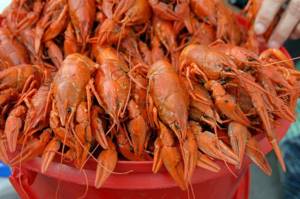
What surprises can await inexperienced fishermen while fishing, what can you get a fine for while fishing, how to avoid becoming a poacher.
Let's try to figure it out together: a fine for fishing during spawning, a fine for catching prohibited species of fish or crayfish, a fine for parking a car near a reservoir, a fine for lighting fires in the wrong place, poaching gear and other possible violations.
Penalty for fishing during spawning
Before we talk about the tools and methods of illegal fishing, we should highlight some aspects of fishing by season.
Many people probably know that there is a spring ban on fishing. The nuance is that the timing of spring spawning of fish is determined at the local level by local legislation.
All this is regulated by the Fishing Rules for each individual fishing basin.
In each region, spring begins differently, and therefore such powers as defining the “month of silence” were given to the subjects of the federation, and rightly so.
During this period, it is strictly forbidden to: ride boats, both without motors and with motors; drive vehicles closer than 200 meters to the water's edge (that is, to the coastline);
Almost all types of recreational fishing are often prohibited, but, as a rule, it is possible to fish from the shore outside spawning areas using strictly defined gear with a certain number of hooks.
That is, during this period, you with amateur gear can be considered a poacher. This is followed by an administrative protocol and a fine.
If you do not pay the fine, then the legislation of our homeland provides for a serious punishment for non-payment of the fine - 15 days of administrative arrest. Yes, such a measure exists, especially if you repeatedly evade paying a fine.
And here's what you need to know: Vibrating tails for pike perch - top 5 best lures
After the end of the spawning ban, you can fish with almost any recreational fishing gear.
Fine for catching prohibited species of fish or crayfish
For the information of fishermen, in each region there is a list of species of aquatic biological resources prohibited for extraction (catch), and the minimum size of extracted (caught) aquatic biological resources (permissible size) is also determined.
Let us remind you that according to the fishing rules, the following types of fish are prohibited for fishing in the waters of Moscow and the Moscow region: sterlet, trout, catfish, grayling, podust, white-eye, blue bream, sabrefish, bersh, lamprey and crayfish.
When fishing for pike perch, bream, pike, burbot and some other types of fish, there are restrictions on their size. By law, you must release them back into the pond.
You should also look for these lists in the Fishing Rules for each individual fishing basin. How to catch crayfish, when you can catch crayfish: Catching crayfish with a crayfish trap.
Fine for parking a car near a pond
By law, your car must be parked no closer than 200 meters from the water's edge; in addition, the car cannot be washed near lakes and rivers throughout the entire year.
If it is winter, then under no circumstances should you drive onto the ice in any vehicle. After all, all the oils and exhaust from the car will remain on the ice and will certainly end up in the water in the spring.
Read more about fines for violating the Water Code here: Recreation by a pond by car - fine from 3.5 to 4 thousand rubles
Article 256, Criminal Code of the Russian Federation. Illegal extraction (catch) of aquatic biological resources.
Article 256, Criminal Code of the Russian Federation. Illegal extraction (catch) of aquatic biological resources.
1 2. .
But, as you know, ignorance of the law does not exempt you from responsibility. Therefore, before putting away hooks, uncovering spinning rods and digging for worms, you should study where, how, what and when it is allowed to fish.
So that later there will be no excruciating pain for a thinner wallet and a ruined vacation. Let's study the laws for fishermen together.
What kind of fishing is considered illegal in the Russian Federation? Punishments and fines in 2018 for illegal fishing How to fish according to the Law - instructions What fishing is considered illegal in the Russian Federation, and where you can’t fish? You can learn more about prohibited fishing from the relevant laws.
And here’s what you need to know: Rigging for pike perch on a spinning rod in the summer
The purpose of this resolution is to preserve the population of fish coming from the sea to rivers to spawn. Catching fish with such nets is quite effective. Just one touch of the fish against the mesh wall is enough for it to become entangled in it.
At the same time, the catch is often carried out with nets with walls measuring thirty by fifteen meters, which is why the scale of the catch is colossal. In addition, as a rule, about a hundred nets are installed at once to catch fish, which poses a danger of complete devastation of the spawning area.
Although this, to put it mildly, is not entirely true. In the literature about crayfish you can find the statement that the most delicious crayfish. caught in months that do not have the letter “R” in their name “May, June, July, August.”
The government's decision on the draft federal law “On recreational fishing” was adopted at a meeting on December 27, 2012. The bill secures the right of citizens to freely and freely carry out recreational fishing on public water bodies, as well as to carry out recreational fishing with registered fisherman’s permits. 6. December 18, 2012.
250 rub. — For the illegal catch of one fish that is allowed to be caught under normal conditions for catching with sporting gear (pike, carp, silver carp).
3000-4000 rub. - For catching in the wrong place.
from 500 to 10,000 rub. — For catching prohibited fish: all sturgeons, all lampreys, whitefish (Volga “nelma”), Caspian trout, Azov shemaya, carp, Russian bystryanka, common sculpin, etc. And also for freshwater crayfish that bear eggs and larvae.
Bait selection
To lure crayfish into a trap, you need to offer them good bait. The most popular and bringing a good catch are:
- bread with garlic;
- fresh fish;
- rotten meat;
- frogs.
Bread with garlic is a fairly simple and catchy bait option. The ideal option would be bread and garlic passed through a meat grinder, well mixed and formed into balls, which are recommended to be placed in small gauze bags. Dill is also added to the mixture if desired.
fresh fish for bait you should pay attention to bream and roach. This type of fish is a delicious delicacy for arthropods. The fish should be cut and turned inside out so that the meat is on the outside. Very often, crayfish fishermen offer rotten meat to their prey. In the warm season, beef liver or chicken gizzard with a well-defined rancid aroma are perfect. A hungry arthropod will quickly approach a pronounced smell.
frog bait is perfect It's quite simple to do. The frog must be cut into 4 pieces, after removing the skin from it. Slices of dried frog are no less catchy.
What kind of fish is found in the Volgograd region
The reservoirs of the Volgograd region are inhabited by a wide variety of fish. Local fishermen very often come home with their catch, but they know where to fish, which cannot be said about visitors. But for those who want to catch fish, this does not pose a particular problem. In local reservoirs you can catch:
- Pike;
- Silver carp;
- Soma;
- Carp;
- Roach;
- Perch;
- Burbot;
- Bream;
- Rudd;
- Carp;
- crucian carp;
- Asp;
- Ruff;
- Goltz;
- Goby;
- Grass carp;
- Herring.
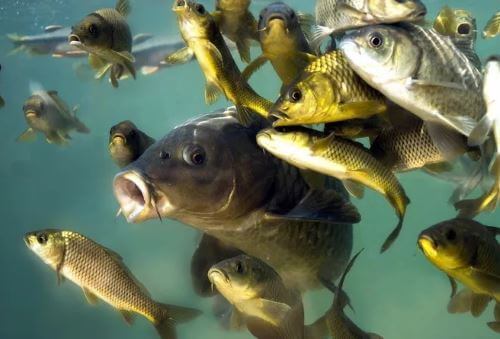
Moreover, there are several reservoirs in which all these types of fish coexist at the same time, although it would seem that they cannot live in the same conditions. Only one conclusion follows from this - you need to know where to fish and how to do it.
Ban on catching crayfish by region of the Russian Federation
When going on a crayfish hunt, you should know that the Fishing Rules in each region establish bans on catching arthropods.
Fishing ban area and periods for each region:
- Astrakhan - 1.04-30.06.
- Bryansk - 1.10–30.06.
- Vladimirskaya – 1.10–30.06.
- Volgogradskaya - 1.01–14.09.
- Vologda – 15.06–31.07.
- Kaliningradskaya - 1.10–30.06.
- Kirovskaya 1.10-30.06.
- Black Sea – from 1.01 to 31.05.
- water bodies of the Azov Sea - from 1.01 to 14.06.
- Kursk - 1.10-30.06.
- Moscow - all year round.
- Novgorodskaya - from 25.05 to 10.06.
- 5.06 to 15.07 – Svetlinsky and Yasensky.
- 15.06 to 10.08 – other areas.
- Pskovskaya - from 1.03 to 15.07.
- Adygea - from 1.01 to 14.06.
- Kalmykia - from January 1 to June 30.
- Mari El - from 1.01 to 15.07 and from 10.08 to 10.09.
- Mordovia - all year round.
- Rostov - 01.01-10.06.
- Samara - from 01.01 to 15.07 and from 10.08 to 10.09.
- St. Petersburg – from melting ice until 15.07.
- Saratovskaya - from 1.12 to 14.07 and from 16.08 to 14.09.
- In Smolensk - 1.10-30.06.
- Stavropol Territory - from 1.12.15.08.
- Tambovskaya – the ban on catching crayfish is valid from 10/1–30/06.
Changes in the Fishing Rules dated November 6, 2018 for 2021
Traditionally, at the opening of the fishing season, changes were made to the Fishing Rules. Now restrictions on the weight of the catch have been introduced for each type of fish. Moreover, in each region these standards are different! In our water area you have to be careful; if you catch a fish on one bank of the Volga and swim to the opposite bank, you can turn out to be a “poacher”. From the text of the Rules it follows that in the territory of the Volgograd region you can catch herring, but you cannot catch blackback herring. But in the Astrakhan region, on the contrary, the blackback is allowed, but the regular one is not. Also, you can now only catch one catfish per day. We are publishing a fragment of the Rules with the latest changes for the Astrakhan and Volgograd regions. We recommend printing it out and taking it with you on fishing trips; it will help in communicating with “particularly zealous” inspectors. For the 2019 season, the crayfish catching dates have changed! Fines for fishing in excess of established limits have increased significantly.
Order of the Ministry of Agriculture of Russia dated November 18, 2014 N 453
(ed. N 153 of 04/19/2016, N 164 of 04/18/2021, N 511 of 11/06/2018 )
“On approval of fishing rules for the Volga-Caspian fishery basin”
V. Recreational and sport fishing
29. Types of prohibited tools and methods of extraction (catch) of aquatic biological resources in all water bodies of fishery importance of the Volga-Caspian fishery basin (with the exception of water bodies of fishery importance of the Astrakhan region):
For amateur and sport fishing, the following is prohibited:
a) application:
networks of all types;
traps of all types and designs (merezh, venter, versh, “muzzle”, “pins”), with the exception of crayfish traps;
passive production (catch) tools (“zakidushki”, “postavushki”, “pokes” and others) on rivers that are habitats for salmon species of fish;
firearms and pneumatic weapons, crossbows and bows;
fishing rods (including bottom fishing rods) and spinning gear of all systems and types with a total number of hooks (single, double or triple) of more than 10 pieces per citizen;
trawling and dredging mining (catch) gear;
net straining and seizing fishing gear (catch) and devices (drags, seines, drags, bastings, lifts, circles, “TVs”, “screens”, “grabs”, “drills”, “shards”, “capes”, “kerchiefs” ", "sakov", "kotsov", "krylatok", "German", "vozmilok", "rezhakov", "okhan" and others), with the exception of lifts ("spiders") and scoops - no more than one piece per citizen , size (length, width, height) of no more than 100 cm, and mesh size (pitch) of no more than 10 mm (including those used with bait) for the production (catch) of live bait (bait), except for especially valuable and valuable species of fish;
piercing fishing (fishing) tools (spears and others), with the exception of amateur and sport fishing carried out using special pistols and guns for underwater hunting;
catfish;
traps;
hook fishing gear;
b) carry out extraction (catch) of aquatic biological resources:
by the method of purpleing, jamming, rutting (including with the help of rattling and bogging);
nets with a total number of hooks of more than 10 pieces on fishing gear for one citizen;
“for illumination” - using lighting devices and lanterns of various designs from the surface and in the water column at night (astronomical, from sunset to sunrise) for the extraction (catch) of aquatic biological resources, with the exception of spearfishing and fishing using fishing rods (including bottom fishing rods) and spinning gear of all systems and names, as well as crayfish traps;
on the track - using a rowing vessel or floating craft using more than two baits per vessel or floating craft;
for trolling - using a sail and/or motor using more than two baits per vessel or floating craft;
circles and girders with a total number of hooks of more than 10 pieces on the fishing gear of one citizen;
by installing driveways, fences, pins, dams and other types of barriers that partially or completely block the bed of reservoirs and watercourses and prevent the free movement of fish;
more than three crayfish traps per citizen, each of the parameters of the permitted crayfish traps (length, width, height - for polygonal ones, height, diameter - for conical and cylindrical ones) should not exceed 80 cm with a mesh size (pitch) of at least 22 mm;
(as amended by Order of the Ministry of Agriculture of Russia dated November 6, 2018 N 511)
using the gill method (when using “fat traps”, “harvesters”) with more than 2 hooks;
wade crayfish by hand or by diving;
c) release of water bodies of fishery importance for the purpose of extraction (catch) of aquatic biological resources;
d) installation of huts and other stationary structures on the ice of water bodies of fishing significance, with the exception of portable windproof devices;
29.1. During amateur and sport fishing on water bodies of fishery importance in the Astrakhan Region, the use of all fishing gear and methods is prohibited, with the exception of the following:
(as amended by Order of the Ministry of Agriculture of Russia dated April 19, 2016 N 153)
float rod, consisting of a rod (including one with guide rings and a removable reel with fishing line), fishing line, float, sinkers, leashes and hooks;
bottom fishing rod (donka), consisting of a rod (including with guide rings and a removable reel with fishing line or cord) or a whip, fishing line or cord, sinker, leashes and hooks;
bottom fishing rod, consisting of a rod (including one with guide rings and a removable reel with fishing line and cord) or a whip, fishing line, sinker, feeder or bait trap with no more than 2 hooks;
bottom fishing rod with shock absorber;
spinners, wobblers, flies and other baits, different in shape and color with hooks (single, double or treble);
crayfish traps, in the amount of no more than three pieces per citizen, each of the parameters of the permitted crayfish traps (length, width, height - for polygonal ones, height, diameter - for conical and cylindrical ones) should not exceed 80 cm;
fishing (catch) on the lane using a rowing vessel or floating craft using no more than two baits per vessel or floating craft;
fishing (catch) by trolling - using a sail and/or motor using no more than two baits per vessel or floating craft;
production (catch) of fish “for kwok”;
boats;
girders;
special shotguns and pistols for underwater hunting;
spinning tackle (spinning), consists of a fishing rod with guide rings and a handle on which a removable reel with fishing line or cord is attached and is equipped with one bait with hooks (single, double or treble). Additionally, a sinker without hooks can be placed in front of the bait.
Double hooks or treble hooks are used only when fishing with a spinning rod and a lure. The total number of hooks used (single, double or treble) should be no more than five pieces on all fishing gear for one citizen.
(as amended by Order of the Ministry of Agriculture of Russia dated April 19, 2016 N 153)
30. Areas prohibited for extraction (catch) of aquatic biological resources, terms (periods) of extraction (catch) of aquatic biological resources, types of aquatic biological resources, minimum size of extracted (caught) aquatic biological resources (commercial size):
30.14. Water bodies of fishery importance in the Astrakhan region:
30.14.1. Areas prohibited for extraction (catch) of aquatic biological resources:
Volga forbidden pre-estuary space;
(as amended by Order of the Ministry of Agriculture of Russia dated April 19, 2016 N 153)
spawning grounds specified in Appendix No. 3 to the Fishery Rules “List of spawning grounds for sturgeon species in the Volga River bed”;
wintering pits specified in Appendix No. 5 to the Fishery Rules “List of wintering pits located on water bodies of fishery significance in the Volga-Caspian fishery basin.”
30.14.2. Prohibited periods (periods) of extraction (catch) of aquatic biological resources:
from May 16 to June 20 - everywhere, with the exception of water bodies of fishing significance within the administrative boundaries of settlements , as well as in fishing (fishing) areas provided for the organization of recreational and sport fishing during this period;
(as amended by Orders of the Ministry of Agriculture of Russia dated April 19, 2016 N 153, dated November 6, 2018 N 511)
from April 1 to June 30 - crayfish.
30.14.3. Types of aquatic biological resources prohibited for extraction (catch):
sturgeon species of fish, herring, except blackback herring, kutum, whitefish, vimba, barbel, burbot, badyaga.
(as amended by Order of the Ministry of Agriculture of Russia dated April 18, 2018 N 164)
30.14.4. Amateur and sport hunting of the Caspian seal is prohibited.
30.14.5. Minimum size of extracted (caught) aquatic biological resources (commercial size):
When carrying out fishing, it is prohibited to produce (catch), accept, process, transship, transport, store and unload aquatic biological resources having a fresh length (in cm) less than that specified in Table 16.
Table 16
| Name of aquatic biological resources | Fishing size, cm |
| Asp | 32 |
| Zander | 37 |
| Bream | 24 |
| Pike | 32 |
| Carp | 40 |
| Freshwater catfish | 60 |
| Roach, roach | 17 |
| Rudd | 17 |
| Chekhon | 22 |
| Tench | 22 |
| Cancers | 10 |
The commercial size of aquatic biological resources is determined in fresh form:
in fish - by measuring the length from the top of the snout (with the mouth closed) to the base of the middle rays of the caudal fin;
in crustaceans, by measuring the body from a line connecting the middle of the eyes to the end of the tail plates.
Extracted (caught) aquatic biological resources having a length less than that specified in Table 16 are subject to immediate release into the natural habitat with the least damage.
30.14.6. The daily rate of production (catch) of aquatic biological resources (except for the case where a permanent or temporary ban on production (catch) during recreational fishing is established for such aquatic biological resources) for each citizen during recreational fishing is indicated in Table 16.1:
Table 16.1
| Name of aquatic biological resources | Daily production (catch) rate |
| Vobla | 5 kg |
| Roach | 5 kg |
| Bream | 5 kg |
| Gustera | 5 kg |
| Carp | 5 kg |
| Zander | 5 kg |
| Bersh | 5 kg |
| Pike | 5 kg |
| Freshwater catfish | 1 copy |
| Tench | 5 kg |
| Chekhon | 5 kg |
| Blackback herring | 5 kg |
| Asp | 10 kg |
| Silver carps | 10 kg |
| white cupid | 10 kg |
| Rudd | 10 kg |
| crucian carp | 10 kg |
| Freshwater perch | 10 kg |
| Sinets | 10 kg |
| Cancers | 50 copies |
The total daily production (catch) rate for all types of aquatic biological resources (except for freshwater catfish), including those not listed in Table 16.1, is no more than 10 kg or one specimen if its weight exceeds 10 kg.
If the total daily norm is exceeded, the extraction (catch) of aquatic biological resources is stopped.
(clause 30.14.6 introduced by Order of the Ministry of Agriculture of Russia dated April 18, 2018 N 164)
30.18. Water bodies of fishery importance in the Volgograd region:
30.18.1. Areas prohibited for extraction (catch) of aquatic biological resources:
in the Volga River:
in the upper pool of the Volzhskaya HPP - at a distance of less than 0.5 km from the dam;
in the downstream of the Volzhskaya HPP - from the dam to the Volga-Akhtubinsky Canal (along the left bank including the lock canal) and along the right bank to the mouth of the Mokraya Mechetka River.
30.18.2. Prohibited periods (periods) of extraction (catch) of aquatic biological resources:
from May 1 to June 30 - in the Volgograd reservoir with rivers flowing into it within the administrative borders of the Volgograd region with all fishing gear, except for one float or bottom fishing rod, spinning rod from the shore with a total number of hooks of no more than 2 pieces on fishing gear (catch) from one citizen;
from April 25 to June 30 in the Eruslan River and its tributaries from the village of Belyaevka within the administrative borders of the Volgograd region;
from May 1 to June 15 - in the Volga and Akhtuba rivers below the dam of the Volga Hydroelectric Power Station, in water bodies of fishing significance of the Volga-Akhtuba floodplain , in the Sarpinsky lakes (Sarpa, Tsatsa) within the administrative borders of the Volgograd region, with the exception of one float or bottom fishing rod with shores with a total number of hooks of no more than 2 pieces on the fishing gear of one citizen outside the spawning grounds specified in Appendix No. 6 to the Fishery Rules “List of spawning areas located on water bodies of fishery significance of the Volga-Caspian fishery basin”;
from April 25 to June 25 - in the reservoirs of the Volga-Don Shipping Canal, with the exception of one float or bottom fishing rod from the shore with a total number of hooks of no more than 2 pieces on fishing gear for one citizen;
from December 1 to July 14 and from August 16 to September 14 - crayfish;
(as amended by Order of the Ministry of Agriculture of Russia dated November 6, 2018 N 511)
from December 15 to February 15 - burbot.
(paragraph introduced by Order of the Ministry of Agriculture of Russia dated November 6, 2018 N 511)
30.18.3. Types of aquatic biological resources prohibited for extraction (catch):
sturgeon fish species, whitefish, blackback herring.
30.18.4. Minimum size of extracted (caught) aquatic biological resources (commercial size):
When carrying out fishing, it is prohibited to produce (catch), accept, process, transship, transport, store and unload aquatic biological resources that have a fresh length (in cm) less than that specified in Table 20.
Table 20
| Name of aquatic biological resources | Fishing size, cm |
| Asp | 40 |
| Zander | 40 |
| Bream | 25 |
| Pike | 32 |
| Freshwater catfish | 90 |
| Carp | 40 |
| white cupid | 50 |
| Silver carps | 50 |
| Cancers | 10 |
| Burbot | 40 |
| (introduced by Order of the Ministry of Agriculture of Russia dated November 6, 2018 N 511) | |
The commercial size of aquatic biological resources is determined in fresh form:
in fish - by measuring the length from the top of the snout (with the mouth closed) to the base of the middle rays of the caudal fin;
in crustaceans, by measuring the body from a line connecting the middle of the eyes to the end of the tail plates.
Extracted (caught) aquatic biological resources having a length less than that specified in Table 20 are subject to immediate release into the natural habitat with the least damage.
30.18.5. The daily rate of production (catch) of aquatic biological resources (except for the case where such aquatic biological resources are subject to a permanent or temporary ban on production (catch) during recreational fishing) for each citizen during recreational fishing is indicated in Table 20.1:
Table 20.1
| Name of aquatic biological resources | Daily production (catch) rate |
| white cupid | 10 kg |
| Asp | 10 kg |
| Golden crucian carp | 10 kg |
| Silver crucian carp | 10 kg |
| Rudd | 10 kg |
| Tench | 10 kg |
| Gustera | 10 kg |
| Sinets | 10 kg |
| Chekhon | 10 kg |
| Ide | 10 kg |
| Bersh | 10 kg |
| Freshwater perch | 10 kg |
| Burbot | 10 kg |
| Zander | 10 kg |
| Bream | 10 kg |
| Carp | 10 kg |
| Freshwater catfish | 1 copy |
| Silver carps | 10 kg |
| Rybets | 10 kg |
| Roach | 10 kg |
| Podust | 10 kg |
| Chub | 10 kg |
| Gorchak | 10 kg |
| Common gudgeon | 10 kg |
| Whitefin minnow | 10 kg |
| Common ruff | 10 kg |
| Dace | 10 kg |
| Loach | 10 kg |
| White-eye | 10 kg |
| Verkhovka | 10 kg |
| Bleak | 10 kg |
| Pike | 10 kg |
| bighead goby | 10 kg |
| Goby-tsutsik | 10 kg |
| Messenger bull | 10 kg |
| Round goby | 10 kg |
| Sandpiper Goby | 10 kg |
| Cancers | 50 copies |
The total daily production (catch) rate for all types of aquatic biological resources (except for freshwater catfish), including those not listed in Table 20.1, is no more than 10 kg or one specimen if its weight exceeds 10 kg.
If the total daily norm is exceeded, the extraction (catch) of aquatic biological resources is stopped.
(clause 30.18.5 introduced by Order of the Ministry of Agriculture of Russia dated April 18, 2018 N 164)
